Springfield Armory is listening to its customer base, first with the Echelon and now with the Prodigy. The Echelon pistols recently released in Desert FDE and OD Green colors, becoming a huge hit for people like me who prefer non-black guns. The latest release from Springfield is the Prodigy pistol in Coyote Brown cerakote.
EXPERT TESTED: Springfield Armory Prodigy in Coyote Brown
While some might be indifferent about this release, I know plenty of others who are probably heading to their FFLs to get their hands on one. I recently attended a media event where I met someone adamant all things come “peanut butter” colored. This included everything from his pistol to his flashlight and holster. And good for him! If a color change is what gets someone interested in buying a gun, I think that’s a win for the 2A community—different strokes for different folks.
When the Prodigy pistols were first released, I was able to review both the 4.25-inch and 5-inch pistols. As a competitive shooter, firearms instructor, and concealed carrier, I was interested in both guns for different reasons. I even purchased the 5-inch model and upgraded it for shooting competitions into a slightly more competitive pistol. The 4.25-inch model Prodigy is ideal for concealed carry due to its high capacity, concealability, compatibility with aftermarket accessories, and accuracy. And for .45 ACP 1911 lovers, a 9mm double-stack 1911 is the next best thing.
Advertisement — Continue Reading Below
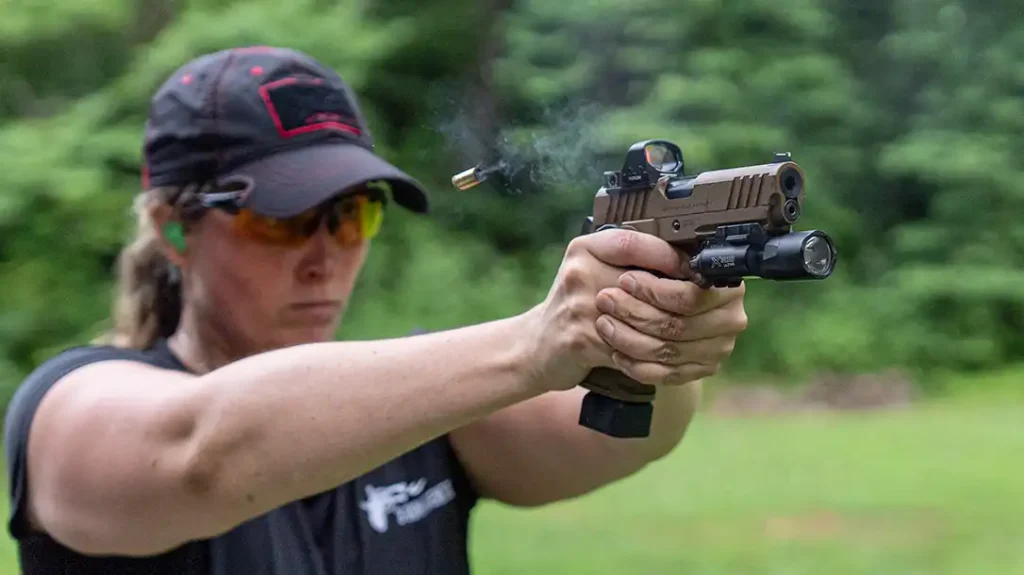
The Springfield Armory Prodigy Pistol
It’s fascinating how the firearm market changes, adapts, and innovates, with each major manufacturer pushing others to keep up with the times. The demand for double-stack 1911s continues to rage, and companies like Springfield, which answer that demand, are winning the consumer market. The 4.25-inch Prodigy pistol released in Coyote Brown features a polymer grip mounted to a forged steel frame, which cuts down on weight compared to many steel-built 1911 pistols. The shorter, more concealable magazine holds 17 rounds of 9mm, a significant increase from your typical seven- to eight-round capacity 1911 pistols. Outfitted with an ambidextrous safety, the pistol serves both right-handed and left-handed shooters.
Let’s Talk Optic Plates
Springfield Armory uses the Agency Optic System (AOS) mounting plates. The design incorporates a rear sight and co-witnesses with almost all red dot optics. There are a few where the irons won’t be visible with the red dot optic. Machined from billet steel, each mounting plate mounts onto the slide, delivering the proper optic height for an intuitive sight picture. Some aftermarket optic plate manufacturers do a decent job making model-specific optic plates. Unfortunately, there are many cheap, plastic, poorly designed optic plates available online, which I don’t recommend using.
Advertisement — Continue Reading Below
I use the AOS on my 5-inch Prodigy pistol and have had no issues losing zero or the plate loosening. Springfield Armory’s plates are some of the best optic plates I’ve used, and they are on par with brands like CZ and Walther, which also make rugged optic plates. An excellent optic plate results in peace of mind, knowing you can rely on your gear.
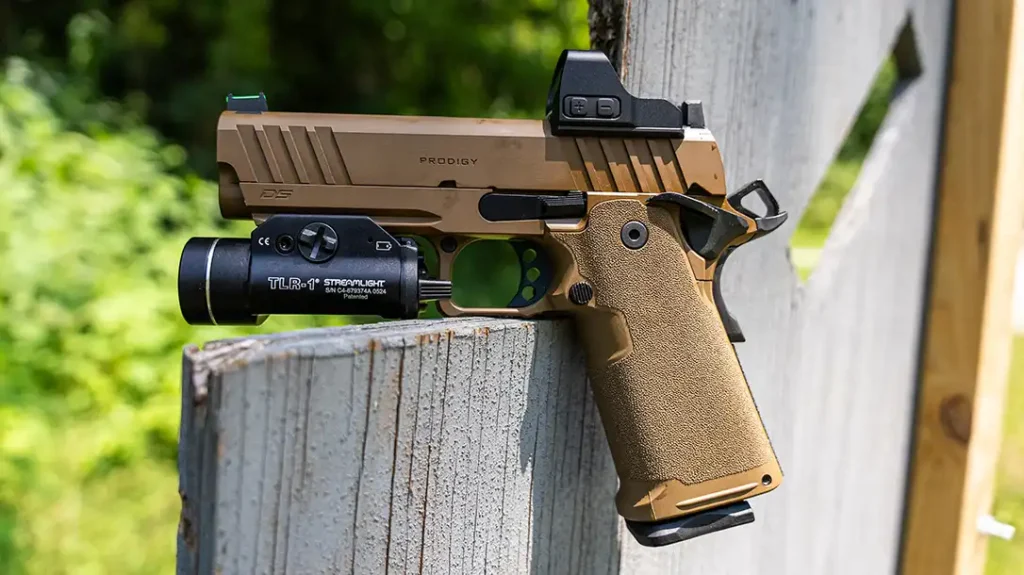
ZeroTech Thrive HD Red Dot
I mounted the ZeroTech Thrive HD Red Dot, a multi-reticle system featuring a 3 MOA dot, 40 MOA circle, and a combination of both. This red dot operates on a CR2032 battery and side loads, so removing the optic from the slide is unnecessary to replace the battery. ZeroTech used the RMR footprint, which is one of the most popular footprints to use. This optic is shockproof, waterproof, and fog-proof. It has an auto shutoff and auto-on functionality, which makes it an excellent option for concealed carry. Adjust your brightness settings on the side, and you’ll be ready to roll.
Advertisement — Continue Reading Below
Weapon Light Mounting
The 4.25-inch Prodigy features a simple, single-point Picatinny rail on the frame’s dust cover for mounting accessories. For carry, I recommend mounting a weapon light to this pistol. Before shopping for a light, I recommend shopping for your holster. It’s like the chicken and the egg with lights and holsters. Not all holster manufacturers accommodate less popular brands of weapon lights. Most all, however, make holsters compatible with Surefire and Streamlight.
The Surefire X300 Ultra slides onto the rail and locks into place via the Picatinny rail slot. It’s easy to remove on and off within seconds. The Streamlight TLR-1 comes with the Glock rail key pre-installed. To be compatible with the Prodigy, change the rail key to the Mil-Standard 1913 (Picatinny). The Streamlight TLR-7X also ships with various rail keys. I used the 1913-1 key to set the weapon light controls close to the trigger guard for easy access and deployment.
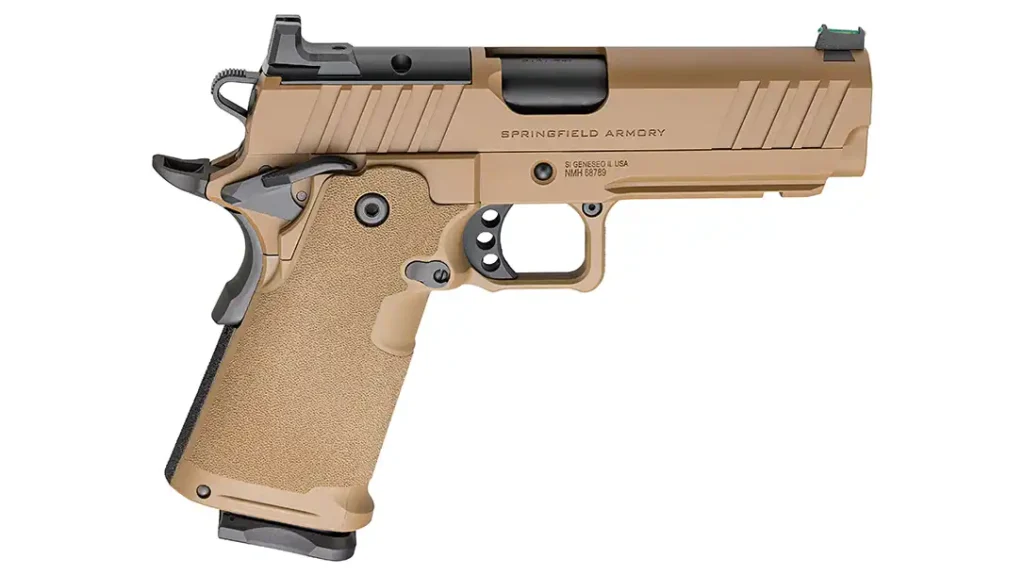
Advertisement — Continue Reading Below
Holster Compatibility
Springfield Armory has vast aftermarket support for the pistols they manufacture. The Prodigy has dedicated holsters custom molded to its slide and frame, but this pistol is also compatible with many 4.25-inch double-stack 1911 pistol holsters. Since most double-stack 1911s are designed similarly in shape and dimensions, it can be easier to find various compatible holsters. Then, there are holster manufacturers who build holsters around the choice of weapon light, with all the retention on the light, rather than the pistol’s trigger guard. It is important to note that many of these holsters are only compatible with 1911s, 2011s, and other full-size pistols. I tested two holsters with the Prodigy, one from Muddy River Tactical and the other from QVO Tactical. I went with the whole Coyote Brown color scheme and had fun with the holster designs.
The Mach Series Duty & Range holster and magazine pouch in Coyote Brown Fiber looked excellent with the new Prodigy but are also designed to perform. An impressive feature of the Muddy River Tactical magazine pouch that most people miss is how the magazine’s retention is adjusted. Instead of tightening the external screws like you would on the trigger guard of a holster, for example, there is a side retention set screw that moves a bar inside of the pouch to add less or more tension onto the magazine. These are the only styles of magazine pouches I like to use, as you can get the retention set to your preference and activity.
The QVO Tactical Secondary OWB Holster was custom molded to the 4.25-inch Prodigy and Surefire X300 light. They have some wild Kydex colors and fabric overlays to make all your colorful dreams come true. I went with the Chocolate Chip camo fabric, which was a total vibe.
Advertisement — Continue Reading Below
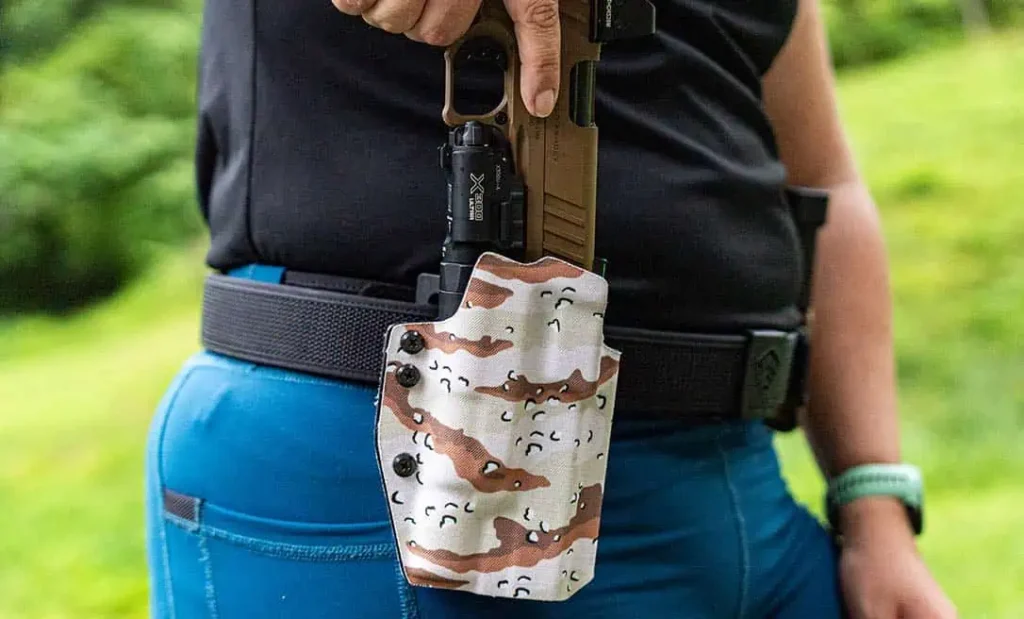
Recommended Belts
Whether you plan to carry or compete with the Prodigy, a sturdy belt is necessary. I have been using the KORE Essentials Competition Belt and am impressed with its durability. You physically cut the inner and outer belts to your size (follow the instructions not to cut too short). The outer belt uses a ratcheting system so you can tighten it to your desired level.
The other belt I used with the Prodigy is the Constantine Carry Belt, a uniquely designed hybrid belt using flexible fabric and rigid material. These come in specific sizes and various colors, and a hook buckle and loop design connect the belt at the front. This belt also works without using belt loops. I bought the very first iteration of this belt when first released. The new update makes it even better.
Advertisement — Continue Reading Below
Eyes and Ears!
If you haven’t heard of Warbird, it is a brand that started out selling body armor but also manufactures hearing protection and eyewear that is ANSI-rated for shooting. The Intrepid Bluetooth muffs are incredibly comfortable, and I can wear them for hours without pain. Rated NRR 23 db, these muffs utilize two omni-directional microphones, Bluetooth and an audio input jack. I also tried out the Enfilade glasses, which were stylish and protective. The temple is very comfortable on the nose, and the frame is soft and UV-resistant. What impressed me most about the eyewear is it comes with a microfiber drawstring bag and a zippered protective case with a morale patch on the outside.
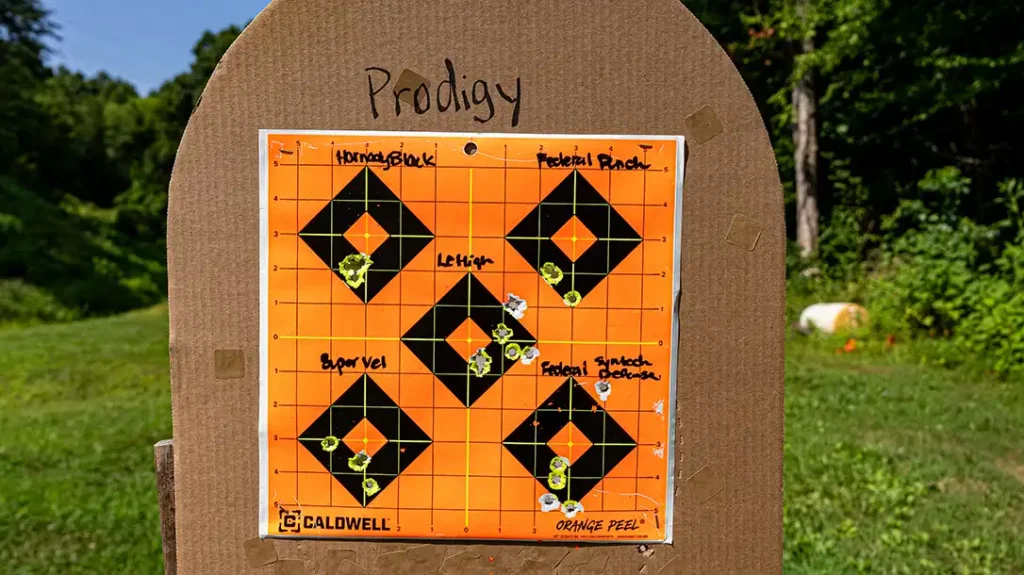
Ammunition & Range Test
| Ammunition | Average Velocity (fps) | Accuracy (inches) |
| Lehigh Defense 90 grain XD | 1,341 | 2.25 |
| Federal Punch 124 grain JHP | 1,166 | 2.75 |
| Hornady Black 124 grain XTP | 1,132 | 0.75 |
| Federal Syntech Defense 138 grain SJHP | 1,057 | 1.50 |
| Super Vel 115 grain SCHP | 1,133 | 2.00 |
Advertisement — Continue Reading Below
I tested the Prodigy with specific defensive ammunition, keeping with most people’s interest in carrying this pistol. I wanted to see if it would all feed reliably with the different bullet profile designs, how fast or slow the velocity would be, and how accurate the ammo would be. There is one round on the Federal Syntech Defense target that I sent high (I didn’t let my dot settle), so that shot I didn’t count in the measurement. The Lehigh Defense bullets left X marks on the target, a sight I had never seen before. I would never want to be on the other end of those bullets. The Hornady Black ammunition shot the best out of the Prodigy, with the tightest group. The slowest velocity, which wasn’t surprising, was from the heaviest bullet grain, the Federal Syntech Defense.
The Prodigy pistol just runs. I knew that before I got my hands on the Coyote Brown model, but I sent a few hundred rounds downrange anyway. Because of the gun’s weight, the felt recoil is mild. The gun has an excellent sight return, making follow-up shots easy. I have always enjoyed shooting any double-stacked 1911 or 2011 pistol, and I am glad to see the new color option Springfield has released!
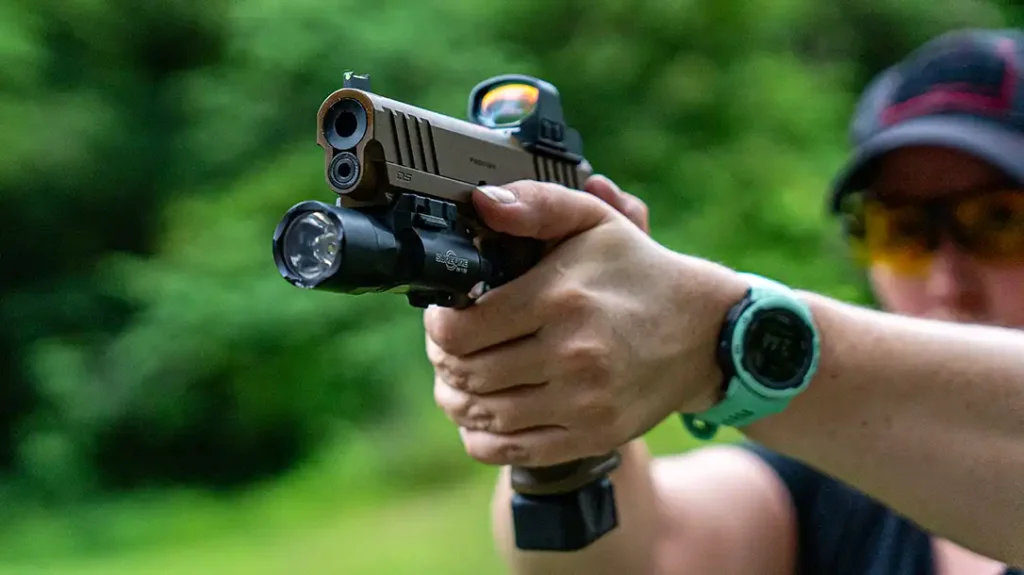
Advertisement — Continue Reading Below
Springfield Armory Prodigy Coyote Brown 4.25 AOS Specs
- Caliber: 9mm
- Color: Coyote Brown
- Barrel: 4.25 inches, Match-Grade Bull, 1:16
- Slide and Frame: Forged Carbon Steel, Coyote Brown Cerakote
- Sights: Fiber-Optic Front, Black Serrated Rear, Optics-Ready
- Capacity: 17- and 20-round magazines
- Height: 5.5 inches
- Length: 7.8 inches
- Weight: 32.5 ounces
- MSRP: $1,549






















